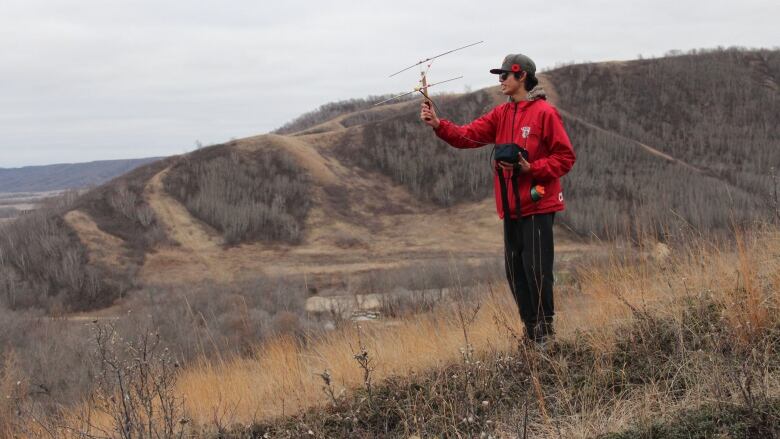Learning the Land program combines Indigenous teachings with scientific knowledge
Program is a partnership between Nature Conservancy of Canada and Treaty 4 Education Alliance

Tracking moose collars isn't something most kids get to do while studying science at school, but that's exactly how students at 11 schools in southern Saskatchewan are learning about the subject.
It's part ofLearning the Land, a program created by the Nature Conservancy of Canada and the Treaty 4 Education Alliance. It combines Indigenous culture and teachings with scientific knowledge about conservation.
"It's a better way to engage students," said Scott Fulton, the program's co-ordinator.
"They've got natural inclinations, I think, for environmental outdoor education, learning that takes them outside the classroom."

This is the third year for the program, whichis carried out through workshops focusing on at-risk species and Prairie conservation.
Taught in both the classroom and the field, it involves elders, scientists, teachers and conservationists.It coincides with the Grade 7 curriculumbut can be adapted for older grades.
"I think it's really important that as humans, we need to reconnect with the environment and develop a greater respect for it. And hopefully this program is helping foster that within the students," said Fulton.
Farmland moose
One way the program is teaching conservation is by teaming up with the Saskatchewan Farmland Moose Project, a research study by the University of Saskatchewan trying to determine why moose are moving from forested areas to farmland.
The moose workshop at theCowessessCommunity Education Centre last monthinvolved students learning to identify animals by their hides and antlers, discovering how the farmland moose were tracked for the study and even getting to try out the tracking equipment themselves.
Grade 11 student Josh Lerat took part.
"Nobody ever does anything like that around here. I liked the different kind of hides because a lot of them were from animals that aren't really from around here," said Lerat.
"I just know about the moose from my own father by hunting with him when I was little. Some of it's kind of traditional, like to respect the animal. You only take what you need and never take anymore."

Moose tracking collars were hidden in bushes on a hill, andstudents tried to usetelemetric equipment to follow the frequency of the collars to where they were hidden.
Lerat says the equipment was harder to use than he thought it would be, and he ended upusing a GPS to locate the collars.
Knowledge keepers
Sometimes an elder or knowledge keeper is brought in to teach students about the traditional uses of moose by Indigenous people during the workshop.
"They are our scholars. Our PhDs, I guess you could say," Lerat said he was told about elders during one workshop.
Fulton says the program is building awareness about the importance of preserving prairie habitat, and Lerat agrees.
"I saw it interested my friends and they were wanting to find out more. They liked it too," said Lerat.
Other workshops featured painter Micheal Lonechild working with students to createa muralof at-risk species in Saskatchewan, and a workshop about careers in conservation.












_(720p).jpg)


 OFFICIAL HD MUSIC VIDEO.jpg)
.jpg)



























































































